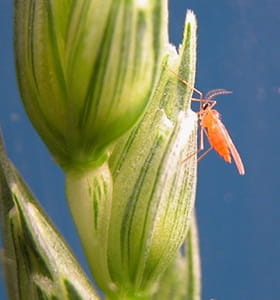By Eileen Beaton, PAg, Crops Extension Specialist, Weyburn
March 2024
Throughout the larval stage, wheat midge (Sitodiplosis mosellana) can cause significant damage to wheat crops in Saskatchewan. The midge larvae feed on the developing wheat kernel, causing it to crack, shrivel and become deformed. Crop damage is not apparent as there is no change in colour, size or shape to the affected wheat head. However, developing seeds within the glumes will show damage symptoms.

Each year, the Ministry of Agriculture conducts provincewide surveys on wheat. In fall of 2023, 359 sites were surveyed to produce the 2023 survey map showing a regional representation of viable wheat midge populations. Soil cores were collected then sent to the Crop Protection Lab where they were assessed for viable larvae. The map can be used by producers and agronomists to view areas that may be problematic during the 2024 growing season.
Wheat midge populations in 2023 were reduced compared to the 2022 survey; however, significant hotspots were found north of Regina, and smaller instances of dense populations were found near Saskatoon, Kindersley and Lloydminster. Do not discount the occurrence of wheat midge, even in regions that are anticipating low levels for the subsequent year. Favourable environmental conditions, particularly timely rains prior to the end of May, can still promote larval development and the emergence of adults in late June/early July. Refer to the Wheat Midge 2023 survey map to view survey results for your area.
Control Methods
If spring wheat is planned as part of a rotation, there are midge-tolerant wheat varieties available as varietal blends. For 2024, varietal blends are available in CWRS, CPSR, CWSP, CWSWS, CWHWS, CNHR, CWES and Durum wheat classes. Visit the Midge Tolerant Wheat Stewardship Team website for information on midge-tolerant wheat and VBs, along with the Saskatchewan Seed Guide.
You can also consider crop rotation to a non-host crop. Since spring wheat is the primary host for wheat midge, planting a non-susceptible cereal crop (e.g. oats, barley) or a broadleaf crop (e.g. canola, pulse) is a good option as midge adults are not strong fliers.
Producers are encouraged to scout their conventional wheat fields during the susceptible period – when the wheat head becomes visible as the boot splits until mid-flowering, to determine midge populations and, if necessary, timing of an insecticide application.
Insecticide options have recently diminished for the control of wheat midge in wheat in Canada. Health Canada cancelled all registrations of insecticides containing the active ingredient chlorpyrifos (e.g. Lorsban® 4E, Nufos®, Pyrifos®, Pyrinex® and Citadel®); therefore, these can no longer be used. Alternative insecticides registered include those containing the active ingredient dimethoate (e.g. Cygon®, Lagon®). Dimethoate application needs to be well timed with the occurrence of adult wheat midge. For more information, refer to the Crop Protection Guide.
If you have any questions about the survey or wheat midge, please contact your local crops extension specialists or call the Agriculture Knowledge Centre at 1-866-457-2377.
